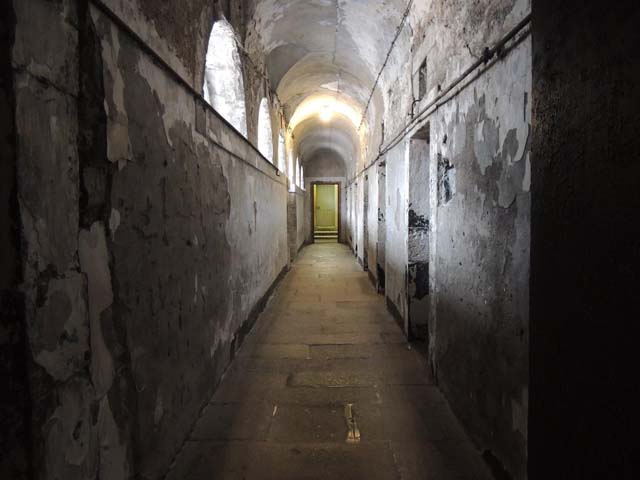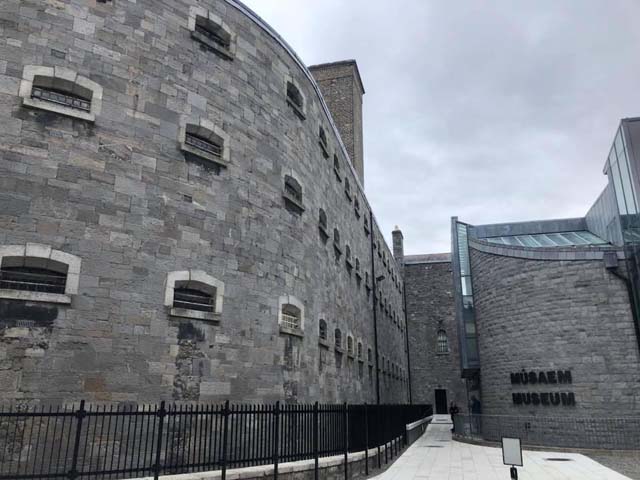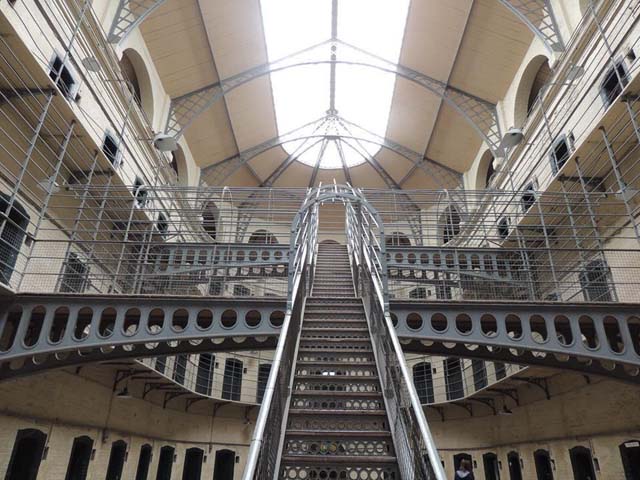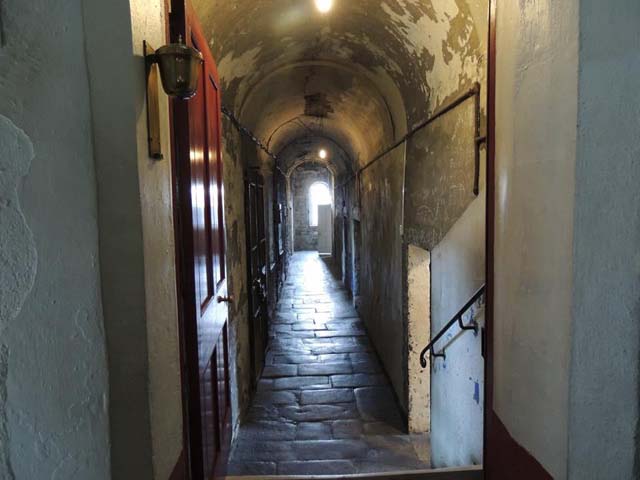Kilmainham Gaol
Inshicore Road,
Kilmainham
Dublin 8
D08 T2X5.
Phone +353(1) 453 5984
Email kilmainhamgaol@opw.ie
Website Resources:
www.kilmainhamgaolmuseum.ie
www.kilmainhamgaolautographbooks.ie
Opening Hours of Kilmainham Gaol
Please note that Kilmainham Gaol is not a part of the OPW free Wednesday
Kilmainham Gaol is open all year except for December 24th, 25thand 26th
April-May – 0900-1800 ( Last tour leaves at 1645)
Kilmainham Gaol, is also home to a wonderful café and in our opinion one of the best gift shops we have ever been in. Their selection of books on Irish History for all ages is outstanding.
They also have a wonderful selection of gifts for every occasion.
What it feels like to Walk through Kilmainham Gaol.

As I walked through the high gates and dark halls, feeling the shadows of the cold walls closing in around me, I was forced to think about the sacrifice that was made in this cold dark place so that we could all be free.
Kilmainham Gaol is one of Ireland’s most visited places, and for me is an essential place to visit for anyone visiting Ireland.
It is a living reminder of how far Ireland has come and is forever engulfed in the memory of those who gave everything for the future generations of Ireland. Kilmainham Gaol is one of Ireland’s most poignant reminders of our turbulent and brutal past.
The walls of Kilmainhan Gaol seem to whisper of the horrors and glory of Irelands past, standing as a silent witness to some of histories most horrific events. Its high walls loom above you bathing you in shadows.
A place where the ghosts of our past walk in silence, historic witnesses, to a history that was in times of crisis soaked in blood and silence.
The men and woman of Ireland’s fight for freedom still present in every step, their lives and deaths preserved inside the walls of a cold prison, a prison that holds the truths of Irelands past.
As you approach Kilmainham Gaol it is impossible not to be astounded and intimidated by the staggering size of Kilmainham Gaol; it’s high thick stonewalls echoing stories of its long and historic past.

The walls seem to whisper of inmates, revolution and those fleeing hunger, it is possible to say that these historic walls are soaked in the blood of the past with the mass executions of our leaders of 1916.
It was a haven for the oppressed and starving people of Ireland would committed crimes of survival to escape the hunger inflicted during the Great Famine, as well as the last place many of our people would ever see. A building with a past soaked in sorrow, bloodshed and cruelty.
Kilmanhaim also tells the story of how the sacrifice and martyrdom of those exceptional people who forever shaped our futures and gave their lives for Ireland’s freedom and for the future generations that would live without oppression and fear.
This magnificent and intimidating structure gives us the opportunity to walk in the footsteps of our sometimes cruel and violent past and allows us to witness the people behind some of Ireland’s most historic events.
As you walk through the intimidating gates of Kilmainham you enter knowing that many of those who walked through these gates would never come out again.
The foundation of Kilmainham Gaol

Kilmainham Gaol is the most historic prison in Dublin City. The Gaol was built in 1796.
The building we see today was referred to as the new Gaol as it was built as a replacement for the Old Gaol of Dublin that had long outlived its purpose and was far to small for the population of Dublin.
Kilmainham Gaol was officially referred to as The County of Dublin Gaol.
It was a one-stop shop for trials, imprisonment and execution.
Trails were carried out within the prison with its purpose built courthouse. Public hangings were originally carried out at the front of the building.
However after 1820 all hangings were carried out within the walls of the prison. This was accessed through a door that is located behind the altar in the Catholic Chapel that is still visible today. A private hanging cell was installed in 1891.
Each cell in the Gaol is roughly 28m squared of solid dark damp stone. Originally men, women and children were all housed together with as many as 5 to these small cells. A dark cold place, with only a single candle to light the shadows.
Each candle had to last 2 weeks. Children were tried the same as adults and Kilmainham saw many children pass through its gates.
Many of these children would have committed petty crimes. It is said that the youngest child to be imprisoned within the walls of Kilmainham was just 7 years old.
The conditions in Kilmainham Gaol were cruel especially for women.

A report in 1809 record that male prisoners were provided with iron bed frames while women prisoners were still forced to sleep on the cold Gaol floors on a bed of straw.
As you walk through the dark passages of the Gaol you are transported back in time.
You can feel the darkness affect you’re the deepest recesses of your heart.
The cold dampness still present the stones still scared and scored. Looking into the darkness of these cells it’s not hard to understand why so many went mad in the brutal isolation within this cloak of darkness with only fleeting shadows of their memory still remaining.
The Gaol saw many periods of reform and renewal during its long life. With the construction of New Wings the cold damp lonely West Wing contained the women’s section after prison reform.
This area was constantly overcrowded and 30 new cells were constructed as female cells in 1840.
They were not long in use when the darkest period in Irish history began “The Great Famine”.
Kilmainham like other prisons across Ireland was left overcrowded to the point of bursting as the ravages of hunger and crimes of survival swept through what seemed to be a shroud of death that was engulfing Ireland.
The Great Famine at Kilmainham Gaol.
The Great Famine also saw a massive increase in crime. The crimes were mainly crimes against property, including the stealing of cattle and food.
They were Crimes of survival. Many were imprisoned due to these crimes, some choosing to commit crimes in order to be sent to Gaol.
Being sent to Gaol was a way to avoid starvation, as harsh and crowded as the Gaol conditions were, they were guaranteed to receive food. Conditions in Kilmainham Gaol at this time were shocking.
There was mass overcrowding in a prison that was not designed to contain the numbers of people that were entering. The meals for prisoners had to be reduced to 2 meals day.
Disease was a major issue, as was the disposal of bodies. During the Great Famine, the Gaol was filled not with hardened criminals but with ordinary people driven to desperation.
At this time these who suffered from mental illness were housed here with criminals.
Hard labour was used as a punishment in Kilmainham and those men sentenced to hard labour were made to break rocks in the prisons Stonebreakers Yard.
Women were sent to work in the prison laundry.
Other aspects in life within Kilmainham were that babies were born here and people died here. A women imprisoned with a baby under 12 months would bring the infant to the prison with her.
It is important to state that although the vast majority of prisoners were there for serious crimes others were there for what we would see now as petty offences.
Kilmainham Gaol has a long association with political prisoners. Kilmainham was used as a holding depot for many prisoners about to have their sentences of transportantion carried out.
Many were sent to Australia as a punishment for their crimes. One of the most famous prisoners to await transportation in Kilmainham Gaol was the Irish revolutionary hero Thomas Francis Meagher for his involvement in the Young Irelanders Rebellion.
He was also the man who gave us our national flag the Tri Colour. Many of Ireland’s most famous revolutionaries were held in Kilmainham Gaol.
These names included revolutionaries of the 1798 rebellion James “Napper” Tandy.
The world famous Irish Nationalist Robert Emmet, who was held in the prison while waiting to be executed for treason.
The room where he spent his last days on this earth can see be seen as it would have been in the Gaol.
He was executed on nearby Catherine Street where he was hung and then beheaded.
There is still speculation and mystery surrounding where Robert Emmet’s remains were buried.
His housekeeper Ann Devlin was also held prisoner in this historic Gaol.
The famous Charles Stewart Parnell also spent his time in prison at Kilmainham. Other famous inmates included the Phoenix Park Murderers from the late 1800’s.
The history of Crime and Punishment through the ages told for the horrific truth that was the reality of our past, Kilmainham Gaol gives you an absolute honest look into the barbaric lives that some prisoners lived inside these haunting walls.
I think it is fair to say that if you were a high status prisoner like Charles Stewart Parnell you would have been housed in comfort and the normal rules would not have necessarily applied or have been implemented.
It is said that Parnell was given excellent care and treatment as he spend time in the Gaol.
The Prisoners and Executions of 1916
The first half on the 20thCentury was to forever intertwine the history of Kilmainham Gaol with that of Irish History. With a decline in the prison population the Prison Board made the decision to close some of its Gaols. Kilmainham Gaol was designated as one that was going to close.
So in 1910 the remaining prisoners were brought to Dublin’s Mountjoy Prison and Kilmainham closed its gates. It was then given to the British Military.
They used it as a billet for their new recruits and as a detention centre for military prisoners.
It was as a Military prison it was to establish Kilmainham and its central role in the Ireland’s bloody struggle for independence. Everything changed with the most important event in the history of Ireland.
The Easter Rising of 1916.

This cataclysmic event was lead by a Military Council consisting of some of Irelands most notorious revolutionary forces, These were The Irish Republician Brotherhood, The Irish Citizen Army, The Irish Volunteers and Cumann na mBan. The rebels seized sites of strategic importance around Dublin City; these sites were all key points of the British administration in Ireland, the heart of British power and control in Ireland.
On that faithful day in history 24thof April 1916 the Irish fight for freedom began. It began with the taking of the GPO on O’Connell street (General Post Office).
This is when Padraig Pearse stood outside and read for the first time the Irish Proclamation of Independence, Poblacht Na H Eireann.
The fighting that ensued over Easter Week 1916, nearly destroyed Dublin with a massive casualty numbers and the city in ruins. Pearse surrendered after 6 long days of constant fighting, this happened from Moore Street in the heart of Dublin.
The leaders were brought to Richmond Barracks except for James Connolly who was badly injured in the GPO and he was brought to a Red Cross field hospital in Dublin Castle.
They were brought to Court Marshal and transferred to Kilmainham to wait for their impending death sentences to be carried out.
It was within the walls Kilmainham that the cruelty which would forever change the course of Irish History would happen.
The Rising resulted in 3,509 people being arrested. 187 were tried at Court Marshals were presided over by Charles Blackader.
General Maxwell decided that the Court Marshals were to be held in secret and the accused were not allowed a defence.
This is why these Court Marshals were later found to be illegal.
Only one woman was Court Marshalled and that was the Countess Constance Markieviez who was kept in solitary confinement in Kilmainham Gaol while she waited for her sentence of death to be carried out.
90 were sentenced to death and 16 of these were carried out, 14 in the Stonebreaker’s Yard of Kilmainham Gaol.
They were led to the Stonebreaker’s Yard, blindfolded, six kneel, 6 six stand, the white handkerchief pinned to their chest, volley after volley rang out over the Gaol, the men dying where they fell. Their light was to shine brightly in the name of Irish freedom for the rest of time.
Padraig Pearse – Kilmainham Gaol – May 3rd1916
Thomas Clarke – Kilmainham Gaol – May 3rd1916
Thomas MacDonagh – Kilmainham Gaol – May 3rd1916
Joseph Plunkett – Kilmainham Gaol – May 4th1916
Edward Daly – Kilmainham Gaol– May 4th1916
Michael O’Hanrahan – Kilmainham Gaol– May 4th1916
Willie Pearse – Kilmainham Gaol– May 4th1916
John MacBride – Kilmainham Gaol – May 5th1916
Eamonn Ceantt – Kilmainham Gaol – May 8th1916
Michael Mallin – Kilmainham Gaol – May 8th1916
Sean Houston – Kilmainham Gaol – May 8th1916
Con Colbert – Kilmainham Gaol – May 8th1916
Thomas Kent – Cork Dention Barracks – May 9th1916
Sean MacDiarmada – Kilmainham Gaol – May 12th1916
James Connolly – Kilmainham Gaol – May 12th1916
Sir Roger Casement – Pentonville Prison. Lomdon – August 3rd 1916
Walking through the narrow halls of this dark prison I am moved by the names above the doors of the small cells, the names of so few who sacrificed so much for so many.
These names are in our minds from our earliest days in school and to see where these brave souls spent their last hours on this earth is an extremely moving and humbling experience.
The fear, the bravery and the feeling of pride in the heroes of our past engulfed me. I was walking where they walked seeing what they saw for the last time.
This was where the letters were written by hands that would never write again. This is where our heroes lay in silence as they prepared themselves to lay their lives down for Ireland’s Freedom all those 16 names in my mind.
So many stories that I will eventually write for them all, knowing so much about them and now I was seeing things for the first time through their doomed eyes.
I think of them the silent resolve of the aging Thomas Clarke, who had spend his life in Irelands Cause, Pearse writing his last letter to his beloved Mother and all the stories of their deeds came flooding back in that instant. I could not be help and think of Joseph Plunkett and Grace Gifford, yes that Grace!
The song we all know this is where that faithful marriage took place, I knew in the chapel I could imagine that night, A bride and a groom brutally surrounded by British Soldiers, Saying their vows knowing that Joseph was doomed to die at dawn, Their faith in each other conquering all that came before it, but they could not conquer death.
After their vows they were ripped apart by the soldiers that witnessed their marriage, Grace evicted out of the prison, Joseph thrown back in his cell.
Later that night Grace was brought along this corridor to this dark cell to visit her husband for 10 minutes.
Two soldiers stood with a watch timing that faithful last meeting that would inspire one of the greatest Irish songs of all time “Grace”. They said their last goodbye and Grace was forced to leave this dark prison.
The cruel deed was done the next morning and Joseph was gone.
Grace did return to Kilmainham as a political prisoner herself during the War of Independence, her painting still visible in her cell.
She would never remarry.
The last goodbyes of all the condemned foremost in my thoughts, the last rights said by priests and friars, the final confessing and forgiveness of sins, last visits and tears of tormented sorrow.
All those final messages being delivered to the ones that they were about to leave, that would feel their loss so deeply.
Those that were executed will never be forgotten.
As I walked into the Stonebreaker’s Yards, the tears started to fall, in pure anger and sorrow at the cruelty, in gratitude for the sacrifice and most of all pride in so few that helped to shaped my own future.
I am forced to think about all those who died when I saw that black cross that marks the point of their death the feelings that swept through me are beyond any words I could write.
In the corner of the Yard is a lonely black cross in the corner this is where James Connolly was executed, the cruellest of the deaths. Connolly had been wounded in the GPO, carried on a stretcher to Moore Street by his men to a safe house until surrender.
Connolly was moved to a Field Hospital in apartments adjacent to Dublin Castle, here the doctors pleaded to the British to allow him to die peacefully in his hospital bed.
After the pleas were ignored for the life of a dying man, to spare him the trauma of facing a firing squad, those pleas fell on deaf ears.

That morning he arrived at the gate of Stonebraker’s Yard by ambulance, he was placed in a chair as he was to weak to stand, so weak that he slumped in the chair, the order was given to tie him to the chair to keep him upright and the shots were fired, his lifeless body tied to a chair.
If you listen hard enough you can still hear those faithful shots that sniffed out the lives of some of Ireland’s brightest minds.
The word of the violent executions soon seeped like blood from the walls of Kilmainham. The men that were once ridiculed were to become the inspiration of a generation.
They were the catalyst that set us on the course for freedom, they were the men who died in the name of a free Ireland and because of them that freedom to rule ourselves to be responsible became not just a dream, but a reality.
Those who changed the world for the better who gave all for the future and for the love of their county, our Country, their people forever grateful to those that would never see the future that they shaped in their own blood.
As unpopular as the Easter Rising of 1916 had been, the fires of temper that the executions of our brave heroes spurred in the people of Ireland would never be extinguished.
The flames of freedom were to engulf Ireland and its people in the fight of Irish Independence.
Those brave men knew they were going to die, possibly even before they entered the GPO and other locations around Dublin. They knew that their deaths would not be meaningless, they had a faith in the strength and will of the Irish people and their spirits that would help us carve out our own nation.
As you leave the Stonebreaker’s Yard spare a thought for the significance of what happened here, how this is where the Irish Nation as we know it was born from the blood of those that loved their country so much that they laid down their lives for their Country and its people.
